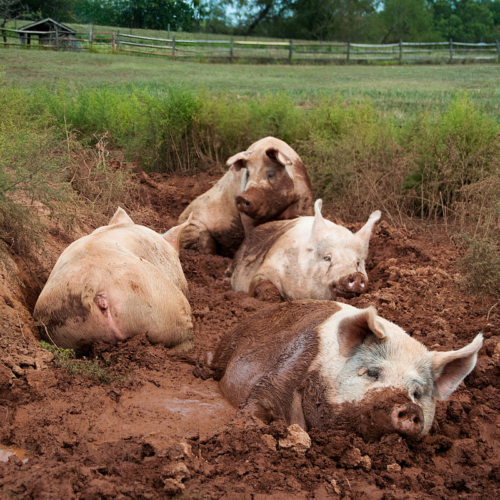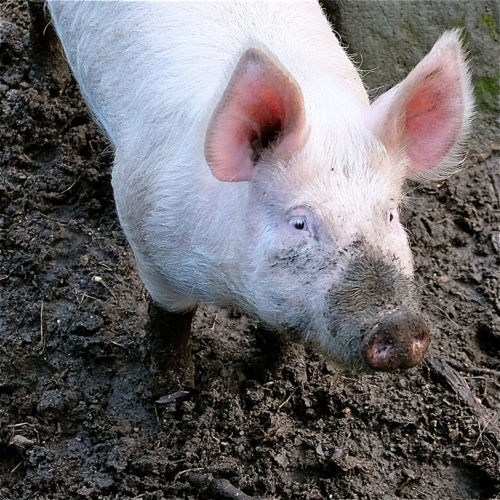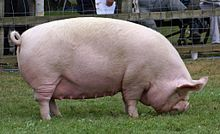Large White Yorkshire Pig
The Large White pig, also known as the English Large White, is a breed of domesticated pig originating in Yorkshire. It is also fondly known as the Yorkshire pig. First recognized in 1868 and registered in 1884 this Yorkshire pig was popular around Keighley West Yorkshire for many years.

Large Whites are distinguished by their hefty bearing, erect ears, slightly dished faces, white color, pink skins, and long deep sides. They have been valued for their bacon production since the inception of the breed. As their name suggests, they are characterized by their large size.
The Large White is regarded as a rugged and hardy breed that can withstand variations in climate and other environmental factors. Their ability to cross with and improve other breeds has truly made them a factor nearly everywhere commercial swine are produced. They have been known for decades as a favorite market animal where high quality bacon and pork are sought. Their tendency to grow and not lay down excess fat have made them favorites, not only when swine are marketed at relatively light weights, but also when they are carried to heavier weights.
Large Whites are known for large litters, heavy milk production and for having excellent maternal instincts. They are not only lean and active, but are also quite sound in feet and legs. They carry their considerable length with ease and grace. Their extra height, or length of leg, helps them to remain active and have long useful lives in the breeding pen.
Small White or Small Yorkshire
The Small White or Small Yorkshire was a breed of domestic pig originating in the United Kingdom and which was common during the nineteenth century. It is now extinct, but its characteristics were used in producing the Middle White and other breeds cross-breeding the traditional Old Yorkshire, a large white pig, with imported Chinese pigs. more for show than bacon or porker This was to lead to the creation of a new type after an incident at the 1852 Keighley Agricultural Show, when pigs belonging to Joseph Tuley, a weaver, were refused entry to the Large White class as they were considered too small; they had been bred by crossing Large White sows with Small White boars.[1] Tuley’s pigs were, however, considered good enough that a new breed was created, the Middle White, which went on to be one of the most popular breeds of pig during the late nineteenth and early twentieth century: it retains the distinctive pricked ears and short snout of the Small White.

The American Yorkshire
The large white breed is the progenitor of the American Yorkshire in North America. They are now known as The American Yorkshires that are white in color and have erect ears. They are the most recorded breed of swine in the United States and in Canada. They are found in almost every state, with the highest populations being in Illinois, Indiana, Iowa, Nebraska and Ohio. The modern Yorkshire is very muscular, with a high proportion of lean meat and low back-fat, in addition to being very sound and durable.
The Yorkshire breed was developed in Englandand were brought to Ohio around 1830. Later the name was changed to “English Large White” but it is known as Yorkshire throughout most of the rest of the world. There are three types of hogs referred to as the Yorkshire: the large, the middle and the small types. Only the large type has ever gained any prominence in the United States.
In 1761, Robert Bakewell became interested in a local tribe of hogs known as the Leicestershire breed and he molded them into a large, useful hog that became popular in England. It is very likely that some, if not most, of the best Yorkshire hogs were cross bred from these pigs.
The Yorkshire breed experienced many ups and downs over the years. In the early 1920’s, the Morrell Packing Company of Ottumwa, Iowa, and the Hormel Packing Company of Austin, Minnesota, tried to promote Yorkshires to farmers around the area. This was following World War I and the market for lard was vanishing. They failed to gain popularity with farmers due to their slow growth rate and short, pugged noses.
The favor of farmers with the Yorkshires didn’t come until the importation of many English Large Whites from the British Isles. Farmers realized what they could do for them and soon started to accept Yorkshire breeding stock. Mothering ability, larger litters, more length, more scale and frame were in such demand that many producers were ready to try Yorkshires again, and this time they were successful.
In the late 1940’s there was a period of rapid breed expansion. A large percentage of Yorkshires were brought in from Canada where the breed had been the most popular breed because of it’s ability to produce the kind of carcass that was in demand in that country. Yorkshires were also being imported from England where they were known for having greater substance, ruggedness, and scale. By selection, and the use of the imported pigs, they met the needs of the pork producer and the demands of the market in this country.
Today, Yorkshires are productive, yet more performance oriented and more durable than ever. The goal of the Yorkshire breed is to be a source of durable mother lines that can contribute to longevity and carcass merit. The motto of “The Mother Breed And A Whole Lot More” indicated the improvement and changes that the industry has seen.
Yorkshire breeders have led the industry in utilization of the “STAGES” genetic evaluation program. From 1990-2006, Yorkshire breeders submitted over 440,000 growth and backfat records and over 320,000 sow productivity records. This represents the largest source of documented performance records in the world.
The American Yorkshire Club was organized on April 1, 1893, in Minneapolis, Minnesota. The office was first in St. Paul, Minnesota, and was moved to Valparaiso, Indiana in 1948. The first club was a stock company. In 1948, the American Yorkshire Club was reorganized and became a membership organization.
The Middle White Breed
The Middle White is a breed of domestic pig native to the United Kingdom. It originated in Yorkshire roughly around the same time as the Large White. Its name comes from the fact that it was between the size of the Large White and the now-extinct Small White. It was fully recognized as a breed in 1884. The breed is known as a pork producer rather than bacon or lard type pigs), and is best known for its sharply upturned snub nose. It is docile and often kept outdoors in grazing situations. Though its numbers have rebounded somewhat, the breed is listed as endangered by the Rare Breeds Survival Trust. Lard is pig fat in both its rendered and unrendered forms. It is obtained from any part of the pig where there is a a fatty deposit.
sources wikipedia and specific breed clubs
